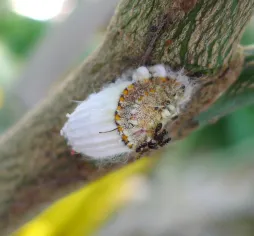Aechmea chantinii, the Amazonian zebra
Not all zebras live in Africa. Aechmea chantinii, also known as the Amazonian zebra plant, flourishes from Ecuador to Peru. This bromeliad stands out for its striped foliage and spectacular flowering.
How to recognize Aechmea chantinii, the Amazonian zebra plant?
Aechmea chantinii is an epiphytic perennial with a flared habit. It measures 60 centimetres in all directions.
The Amazonian zebra plant is aculeate. Its leaves grow in a rosette to form a tube. The hollow center serves as a reservoir for rainwater. The elliptical leaf blades reach 90 centimetres in length. Coriaceous, their margins are bristling with teeth. The bright green leaves are striped with dark green or gray. The more regular pattern and darker color of aechmea fasciata differentiate the two species.
Aechmea chantinii flowers in summer, when it is three or four years old. A floral spike emerges from the heart of the leaf rosette. It is made up of red or orange drooping bracts. Red flowers bloom on top. But this flowering sounds like the swan's song. The Amazonian zebra plant blooms just once before dying. It does, however, take the time to produce shoots at its base, giving rise to clones.
The plant has inspired botanists and given rise to numerous cultivars. Aechmea chantinii Samurai is distinguished by its leaves marked in the center by a yellow stripe, Aechmea Chantinii Black has white foliage zebra-striped with black, and Aechmea chantinii Shogun has dark green leaf blades with yellow margins.
Like aechmea caudata, the Amazon zebra plant is non-toxic. It presents no danger when eaten or touched. Just be careful not to prick yourself with the thorns on the leaf blades.
Our maintenance tips
Aechmea chantinii are often sold already in flower. If you're growing offshoots, be patient! It takes three or four years for the plant to flower.
Watering
Always water your aechmea chantinii with fresh water at room temperature. Preferably use rainwater.
When watering, pour the water into the heart of the plant, into the reservoir formed by the leaves. Water regularly, but not heavily. Keep the soil moist in summer, but allow the surface to dry out in winter.
Aechmea chantinii like to keep two to three centimetres of water at the heart of the rosette. But don't let the water stagnate too long. Before watering, drain off any residual water by tilting the plant slightly.
Spray
Mist foliage with non-calcareous water at room temperature.
Also spray the substrate to keep it slightly moist.
Repotting
Every spring, repot your Aechmea chantinii to give it more space.
Choose a pierced pot twelve to fifteen centimetres in diameter. Line the bottom with a bed of clay balls for drainage.
Then add an aerated substrate. You can buy potting soil for bromeliads or mix orchid potting soil, perlite and coconut fibre. Plant aechmea chantinii in the center, without burying it too deeply.
To maintain a high level of humidity, place the pot on a dish filled with moist clay balls.
Fertilization
To promote the growth of your Aechmea chantinii, apply fertilizer in spring and summer.
If you want to speed up your plant's growth, feed your Aechmea chantinii with a green plant fertilizer.
Cleaning
It is not advisable to clean the foliage. Leaves are covered with trichomes, small transparent hairs that capture moisture. They are fragile and can be damaged by dusting.
If your plant gets dusty, it's best to baste the foliage with lukewarm water.
Cutting
Wait until the end of flowering to propagate your Aechmea chantinii.
After flowering, your Aechmea chantinii produces shoots. You can take them to propagate the plant. When they are about ten centimetres long, you can separate them using your hands or a clean knife.
Prepare a pierced pot adapted to the size of your cutting. Aechmea chantinii like to be cramped. The container doesn't have to be large (eight centimetres in diameter is enough), but it should be deep enough to support the weight of the plant without tipping over.
Place a layer of clay balls at the bottom for drainage. Then add a potting soil for bromeliads. You can also make your own substrate by mixing orchid potting soil and green plant compost.
Plant your seedling in the center of the pot. Don' t bury it too deeply. Pack lightly and water with non-calcareous water to moisten the soil.
Cuttings sometimes have trouble standing up straight on their own. You can stake the plant to support it.
Disease / Threat
Information
| Family | Bromeliads - Bromeliaceae |
| Type | Aechmea - Aechmea |
| Species | Aechmea chantinii - Aechmea chantinii |
| Lifecycle | Perennial |
| Foliage | Evergreen |
| Exposure | |
| Substrat | |
| Planting method |
In pots |
| Categories | |
| Tags |
Beginner Flowery |
| Origins |
Central America South America |
| Hardiness (USDA) | 11a |
| Leaf color |
|
| Flower colors |
|
Discover plants from the same family
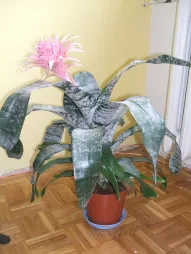
Silver vase
Discover
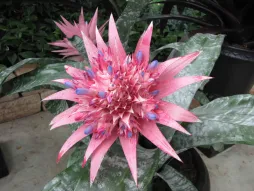
Aechmea Primera
Discover
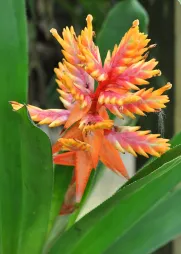
Aechmea 'Pepita Elegant Flames'
Discover
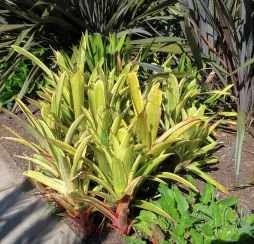
Aechmea caudata
Discover












